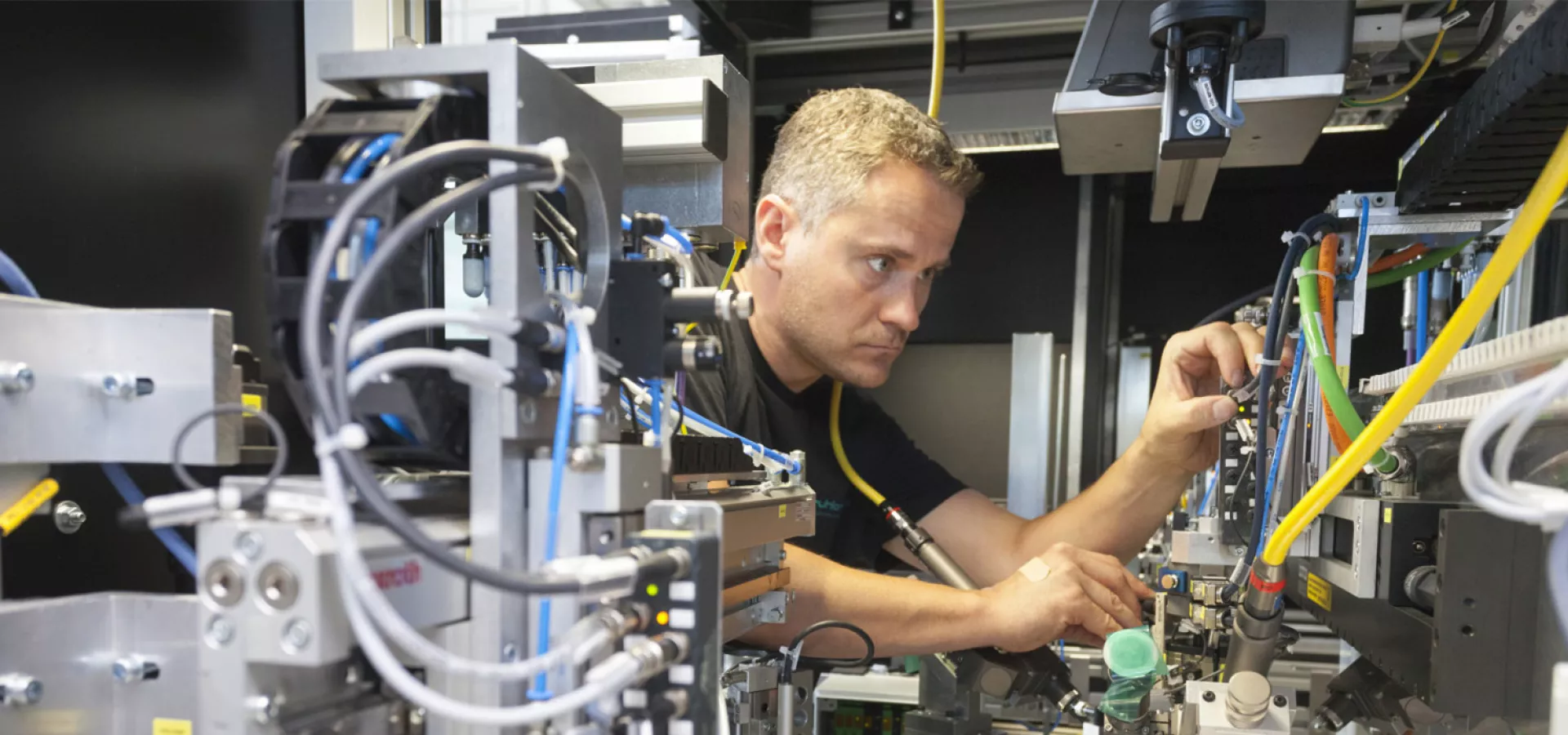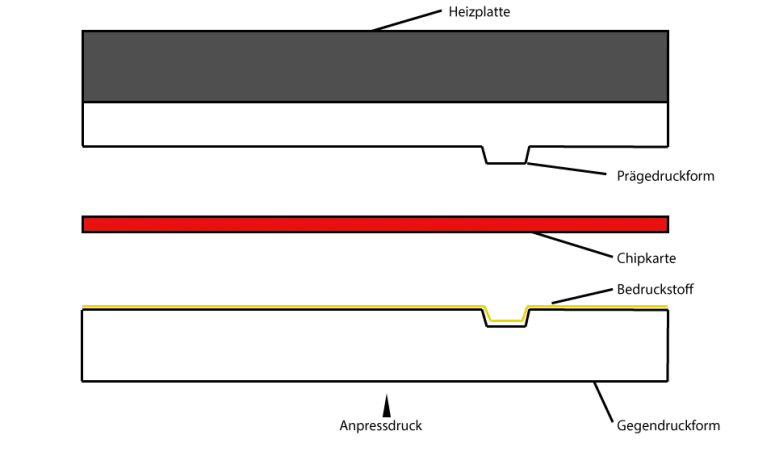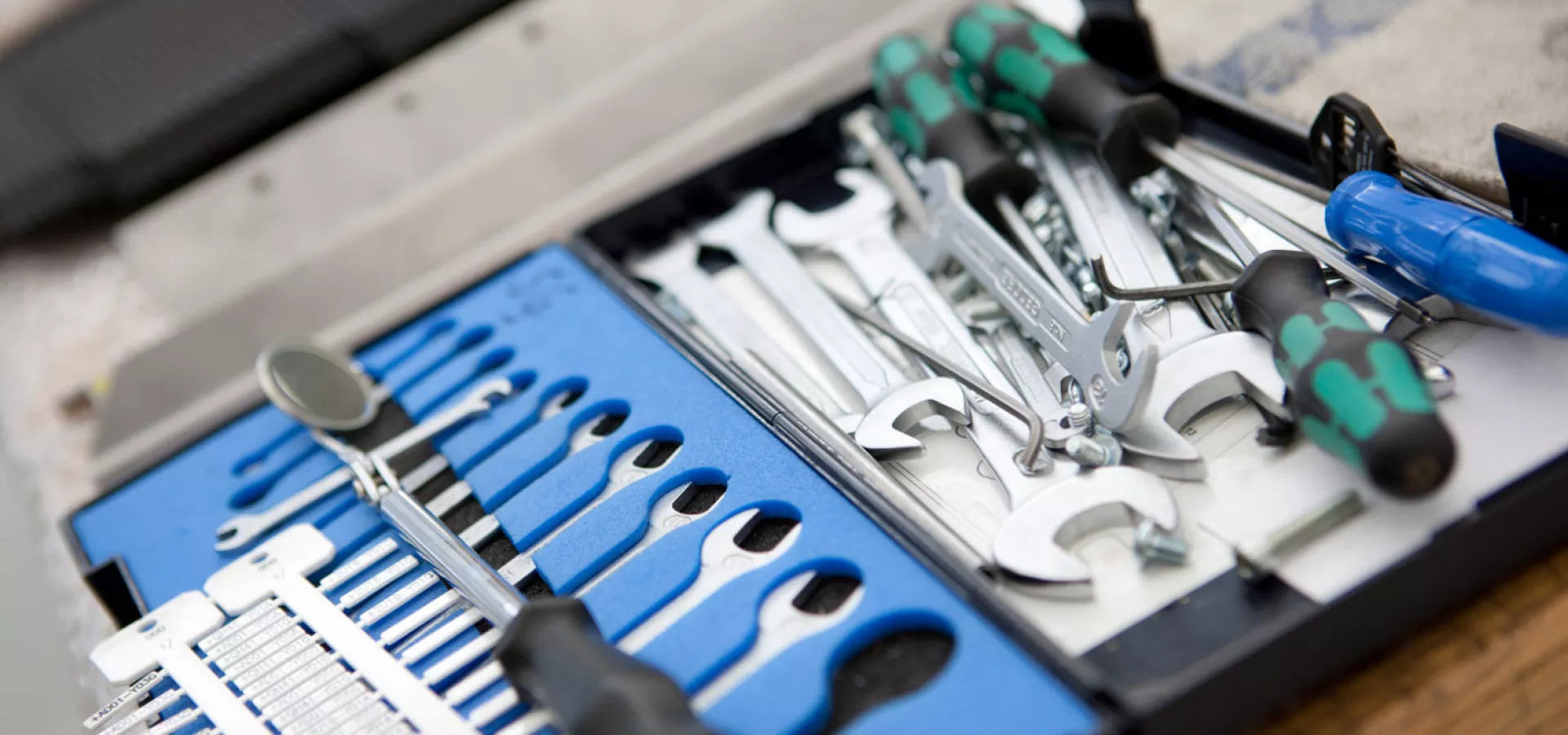
Bank card personalisation using drop-on-demand inkjet printing
Through the ever growing number of bank cards, as well as magnetic stripes being globally replaced by modern EMC- based security technologies, there is a high demand for bank card personalization. After further development of the first printing processes, thermal transfer and embossing technology, DOD printing is increasingly in demand because the product is better and more cost effective. The world's two largest credit card companies, MasterCard and Visa, have approved this technology for all their products.
The types of bank card personalization at a glance:
Embossing technology
The first method used for the personalization of plastic cards, and today mainly for credit cards, is embossing technology. A heated, metallic embossed printing die is pressed with great force into the back of the plastic card. On the front of the card, a negative of the printing die is used to press a monochrome ribbon on the punched areas and transfer the ink. Credit cards often use silver or gold leaf instead of color. The result is aesthetically pleasing and very durable.
When credit cards were processed mechanically, the embossing was used to carry out the transactions. For this purpose, the embossed number was printed using an imprinter, better known as a credit-card carbon-copy machine, along with the amount to be paid on a receipt. This receipt had to be taken to the bank by the customer in order for the transaction to be carried out. With the advent of electronic payment methods, the embossing process has increasingly lost this technical purpose because electronic payment processes are much faster and solvency can be checked directly during the checkout process.

Thermal transfer
Thermal transfer printing is a widely used method for the personalization of smart cards and is universal for printing 3D objects. The imaging is carried out by a special ink film, which is placed between the substrate and a thermal print element. The thermal print element contains a large number of controlled heating elements, which heat the film at certain points to transfer the ink. In order to print multicolored images, either multiple printing elements are used (single-pass system) or different colors periodically appear on the printing ribbon (multipass - system). Accordingly, for a four-color image there are four individual ink transfer processes. Since thermal transfer systems have resolutions of up to 600 DPI, they are also often used for printing photographs.
Inkjet
The inkjet method is one of the most widely used technologies in digital printing systems and is also commonly used in inkjet printers. Using computer-to-print (CTP) technology, the print data are processed by the computer and sent to a printing unit, which requires no additional plates or other aids. The imaging is carried out by directly spraying the ink using controlled nozzles. This allows the to-be-printed information to take shortest path to being transferred onto the image carrier.
There are two different methods of inkjet printing. The first uses continuous inkjet technology, where small droplets of ink continuously streaming from the nozzle are guided onto paper depending on the image. The second method is drop-on-demand, where ink drops only leave the nozzle when they are needed for the image. DOD technology plays a significantly larger role in both the personalization of smart cards as well as in household inkjet printers.
Types of drop-on-demand
Thermal inkjet
The thermal inkjet method is based on the resulting pressure differences from heating the ink. For this purpose, a heating element is installed in the nozzle, which brings the ink up to its boiling point. This turns part of the ink into gas, thus generating high pressure that “shoots” the ink from the nozzle onto the printing material. As the temperature decreases, the gas condenses in the nozzle creating lower pressure than in the adjacent ink reservoir, which causes ink to be sucked back into the nozzle.
With thermal inkjet technology, drop volumes of about 23 pl are able to be reached, which means a resolution of 600 DPI is possible. This means that the standard size of smart cards in ID-1 format corresponds to a resolution of about 2000 * 1250 pixels. This allows many design options and focus depths for photographic images or other pictures to be printed. The drop frequencies lie in the range of 5 - 8 kHz, allowing a single chip card to print in approximately 125 seconds with a minimum number of four nozzles (black, cyan, magenta and yellow). In modern inkjet systems arrays are possible with thousands of nozzles, which shorten production time proportionally.

Piezo inkjet
The piezo inkjet method works in similarly to thermal inkjet, but the ink is shot out of the nozzle mechanically without heating. To generate the necessary pressure differences, piezo ceramics is used. These are materials that, when below the Curie temperature (150 ° C - 200 ° C), spontaneously change shape or volume due to electromagnetic forces. Applying voltage to the ceramic deforms them, as when used in piezo tweeters. The effect also works vice versa in things such as electric lighters or turntables, where voltage is generated through deformation.
In printing technology, the so-called bend mode is used, for which piezo ceramic material forms the back wall or ceiling of the nozzle reservoir. Voltage is applied to the ceramic material, which bends thus changing the volume of the ink reservoir. A drop is formed and new ink is once again drawn into the reservoir when the voltage ceases and the piezo ceramic material bends back. During shear mode, the piezo ceramic material is controlled differently, so that crystals produce gravity. The crystals, which are fixed to the top of the nozzle reservoir, cause trapezoidal distortion. This produces the necessary pressure for a drop to form.
Significantly higher droplet frequencies of up to 125 kHz are possible with piezo inkjet technology. Other advantages are that the color does not have to be heat resistant and pigmented inks can be used. The production costs are a disadvantage since piezoelectric ceramics have a significantly higher base price than a simple heating resistor.


Summary
Embossing is an older method, which never really further developed and is almost exclusively found on credit cards. Embossed plastic cards are intended to give the customer an impression of higher value. However, holograms, high-resolution printed microtext or guilloche patterns are used for security purposes. The characters per line and fonts are still very limited, so that embossments can easily be imitated. Therefore, embossing now serves more as a visual enhancement than as a security feature. While in the United States no embossed credit cards have been issued since 2008, in Germany they are currently in high demand for prepaid credit cards as they seem to create a feeling of a "real" credit card and suggest high solvency, which does not have to be true.
Advantages of embossing are the almost unlimited durability, as well as the mechanical readability of the embossed numbers. It is still in use in many countries, especially outside of Europe, where electronic detection devices for payments are not widespread. Embossing can be problematic with the use of contactless RFID cards as it could damage the antenna, which is why special attention must be given to the geometry of the card.
Inkjet printing is a successful alternative to previously used methods for personalizing smart cards. This allows the previously mentioned modern security features to easily be printed.
Operating costs can be significantly reduced compared to thermal transfer printing, in some cases by more than 90%. Using special UV inks, the inkjet method provides for smart cards that are much more resistant to abrasion and therefore have higher durability. The personalization process is up to three times faster to produce and, thanks to non-contact pressure, nearly free from wear and thus can often be repeated. Since inkjet is a CTP technology, it is very easy to adjust the design, data, font or any such things, which makes personalization incredibly flexible.
Generally, with inkjet printing it is simple to recognize many advantages over older technologies and it now appears that it will be the most widely used method for the personalization of bank cards in the near future. With the continuous development of 3D inkjet printing, new mechanically detectable security features will certainly arise.
